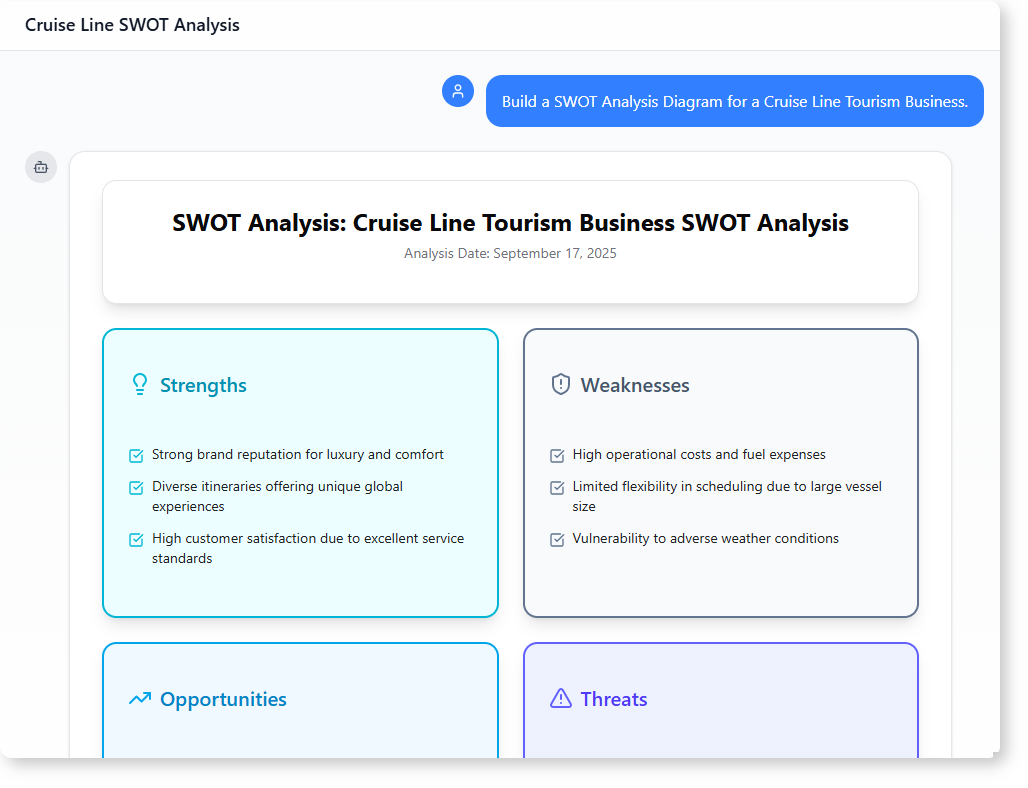Now Reading: How to Generate a Professional SWOT Analysis with AI-Powered Modeling Software
-
01
How to Generate a Professional SWOT Analysis with AI-Powered Modeling Software
How to Generate a Professional SWOT Analysis with AI-Powered Modeling Software
How to Generate a Professional SWOT Analysis with AI-Powered Modeling Software
Imagine you’re a strategic planner for a cruise line. You’re looking to assess the current business landscape and identify key factors shaping its future. Instead of spending hours researching or manually drafting a SWOT analysis, you can get a clear, structured, and realistic view in minutes.
This is exactly what AI-powered modeling software does — it turns natural language prompts into visual and textual insights. In this example, a user asked the AI to generate a SWOT analysis for a cruise line tourism business. The result? A complete, well-organized SWOT diagram and a detailed interpretation that could be used in business planning or stakeholder presentations.

Why This Approach Works for Real-World Business Decisions
Traditional SWOT analysis tools often require a lot of manual input. You might spend time listing points, organizing them, and even deciding whether to include certain factors. With AI-powered modeling software, the process becomes intuitive and focused.
The software understands the context — like a cruise line operating in a competitive, environmentally sensitive market — and generates a balanced, realistic analysis. It doesn’t just list items; it interprets them with attention to feasibility and impact.
The User’s Journey: From Prompt to Insight
The user began by entering a straightforward request:
“Build a SWOT Analysis Diagram for a Cruise Line Tourism Business.”
Instead of being asked to define each category, the AI automatically structured the analysis around the standard SWOT framework — strengths, weaknesses, opportunities, and threats — while grounding each point in the realities of the cruise industry.
After the diagram was generated, the user followed up with a second prompt:
“Prepare a detailed written interpretation of the diagram that could be used for documentation.”
The AI responded not with bullet points, but with a clear narrative that explained the significance of each category. For example, it highlighted how a strong brand reputation for luxury directly supports premium pricing, while also noting the risk of rising environmental regulations.
This two-step process shows how AI-powered modeling software supports strategic thinking — not just by generating content, but by helping users understand it.
What the AI Delivered
The resulting SWOT analysis for the cruise line includes:
-
Strengths:
-
Strong brand reputation for luxury and comfort
-
Diverse itineraries offering unique global experiences
-
High customer satisfaction due to excellent service standards
-
Weaknesses:
-
High operational costs and fuel expenses
-
Limited flexibility in scheduling due to large vessel size
-
Vulnerability to adverse weather conditions
-
Opportunities:
-
Increasing demand for eco-friendly and sustainable tourism
-
Expansion into new markets like the Pacific and Caribbean
-
Integration of immersive experiences like cultural workshops
-
Threats:
-
Rising environmental regulations and carbon emissions rules
-
Global economic downturns reducing discretionary spending
-
Competitive pressure from budget airlines and all-inclusive resorts
The output is not just a list. It’s a thoughtful, context-aware breakdown that reflects the dynamics of a modern tourism business. The written interpretation adds value by explaining why each point matters — for instance, linking high fuel costs to long-term financial risk.
Why This Is a Better SWOT Analysis Tool
Most SWOT tools are static. They rely on user input and offer little in the way of context or insight. This AI-powered modeling software goes beyond that.
It understands industry-specific challenges. It doesn’t assume all businesses operate the same way. For a cruise line, factors like environmental compliance, global travel trends, and fleet size matter. The AI recognizes these nuances.
This makes the output more actionable. It’s not just a template — it’s a conversation between a business strategist and a model that understands their world.
Is This the Future of Business Analysis?
Not just for SWOT analysis. This same approach applies to other types of modeling — from business strategy to risk assessments. AI-powered modeling software doesn’t replace human judgment. It enhances it by offering structured, context-aware insights based on real-world patterns.
You don’t need to be an expert in data or modeling to get value from this. Just ask clearly, and let the tool do the heavy lifting.
FAQ
Q: Can AI-powered modeling software create a SWOT diagram for any business?
A: Yes. The software is designed to adapt to different industries. Whether it’s a cruise line, a tech startup, or a retail chain, it generates relevant and realistic SWOT points based on the context provided.
Q: How does the AI interpret the SWOT elements?
A: The AI uses pattern recognition and business knowledge to interpret each category. It doesn’t just list points — it explains their significance, like how high operational costs tie into long-term profitability.
Q: Is the SWOT analysis generated by the AI suitable for documentation?
A: Absolutely. The output includes both a visual diagram and a detailed written interpretation, making it ready for reports, presentations, or internal reviews.
Q: Can I use this AI tool to generate a SWOT analysis for a cruise line expansion into new markets?
A: Yes. You can refine the prompt to include specific goals — like “Generate a SWOT analysis for a cruise line expanding into the Pacific region.” The AI will then tailor the analysis to that specific opportunity.
Ready to map out your system’s interactions? Try the AI-powered modeling software at Visual Paradigm’s AI Chatbot.
